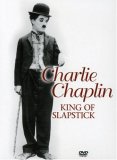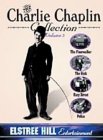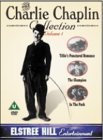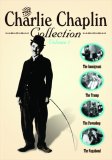 Charlie Chaplin - King Of Slapstick | DVD | (02/11/2007)
from £N/A
| Saving you £N/A (N/A%)
| RRP
Charlie Chaplin - King Of Slapstick | DVD | (02/11/2007)
from £N/A
| Saving you £N/A (N/A%)
| RRP ![The Chaplin Collection Vol. 2 [DVD]](/pictures/1133402.jpg) The Chaplin Collection Vol. 2 | DVD | (04/04/2014)
from £11.86
| Saving you £-4.87 (-69.70%)
| RRP
The Chaplin Collection Vol. 2 | DVD | (04/04/2014)
from £11.86
| Saving you £-4.87 (-69.70%)
| RRP This DVD invites you to experience some famous silent film episodes with the legendary world star Charlie Chaplin.
![Charlie Chaplin Collection 2 [DVD]](/pictures/1096812.jpg) Charlie Chaplin Collection 2 | DVD | (26/10/2009)
from £4.98
| Saving you £7.00 (234.11%)
| RRP
Charlie Chaplin Collection 2 | DVD | (26/10/2009)
from £4.98
| Saving you £7.00 (234.11%)
| RRP Charlie Chaplin Collection 2 contains: Tillies Punctured Romance: Charlie Chaplin stars as a smooth city slicker conman in this silent classic and he seduces farm girl Marie Dressler into stealing her fathers money then he leaves her upon discovering that she is to be a wealthy heiress he returns to marry her but her rich uncle and the Keystone Cops make an appearance. This was Chaplins 35th film and his last for Keystone. Knock Out: A couple of tramps down on their luck and hungry decide to fake an exhibition boxing match for a promoter. Meanwhile Pug a good-hearted but boisterous fellow takes on a gang of mashers who make unwanted advances to his girlfriend. Impressed by his abilities the mashers decide to pass Pug off as Cyclone Flynn the champion and enter him in the boxing match. But the real Cyclone shows up and he and Pug battle it out in the ring. Soon the fight progresses to include pistols rooftop chases and the Keystone Kops in hot pursuit.
![The Serpent's Kiss [1997]](/pictures/1037512.jpg) The Serpent's Kiss | DVD | (31/07/2006)
from £N/A
| Saving you £N/A (N/A%)
| RRP
The Serpent's Kiss | DVD | (31/07/2006)
from £N/A
| Saving you £N/A (N/A%)
| RRP ![Charlie Chaplin Collection Vol.6 [DVD]](/pictures/1097479.jpg) Charlie Chaplin Collection Vol.6 | DVD | (25/01/2010)
from £6.98
| Saving you £5.00 (100.20%)
| RRP
Charlie Chaplin Collection Vol.6 | DVD | (25/01/2010)
from £6.98
| Saving you £5.00 (100.20%)
| RRP Charlie Chaplin: Collection 6
![Charlie Chaplin Collection 3 [DVD]](/pictures/1096993.jpg) Charlie Chaplin Collection 3 | DVD | (02/11/2009)
from £9.90
| Saving you £0.09 (0.90%)
| RRP
Charlie Chaplin Collection 3 | DVD | (02/11/2009)
from £9.90
| Saving you £0.09 (0.90%)
| RRP Including A Woman Mother Father and Daughter go to the park. The women dose off on a bench while the father plays a hide-and-seek game with a girl blindfolded. Charlie leads him into a lake. Both dozing ladies on the bench fall for Charlie and invite him for dinner. The father returns home with a friend. Charlie rushes upstairs and dresses like a woman shaving his moustache. Both men fall for Charlie. His Regeneration A rough criminal gets into an argument over a girl in a dance hall. The argument turns into a fight and the criminal is shot. As everyone else looks on a young woman comes to his aid and it turns out that he is not seriously wounded. He still remembers the woman who helped him when later he is committing a burglary and gets a surprise that will change his life The Bank Charlie does everything but an efficient job as janitor. Edna buys her fianc'' the cashier a birthday present. Charlie thinks To Charles with Love is for him. He presents her a rose which she throws in the garbage. Depressed Charlie dreams of a bank robbery and his heroic role in saving he manager and Edna ... but it is only a dream. Shanghaied A shipowner intends to scuttle his ship on its last voyage to get the insurance money. Charlie a tramp in love with the owner's daughter is grabbed by the captain and promises to help him shanghai some seamen. The daughter stows away to follow Charlie. Charlie assists in the galley and attempts to serve food during a gale.
![Wax [DVD]](/pictures/1131887.jpg) Wax | DVD | (11/08/2014)
from £16.45
| Saving you £N/A (N/A%)
| RRP
Wax | DVD | (11/08/2014)
from £16.45
| Saving you £N/A (N/A%)
| RRP  Charles Chaplin: A First National Collection | DVD | (14/03/2000)
from £N/A
| Saving you £N/A (N/A%)
| RRP
Charles Chaplin: A First National Collection | DVD | (14/03/2000)
from £N/A
| Saving you £N/A (N/A%)
| RRP ![Charlie Chaplin - Gold Rush [1925]](/pictures/1012277.jpg) Charlie Chaplin - Gold Rush | DVD | (22/09/2003)
from £N/A
| Saving you £N/A (N/A%)
| RRP
Charlie Chaplin - Gold Rush | DVD | (22/09/2003)
from £N/A
| Saving you £N/A (N/A%)
| RRP Chaplin's personal favourite among his own films, The Gold Rush embodies all the trademarks of his mix of slapstick, satire, social commentary and sentiment--a perfect showcase for his ever-popular Little Tramp. Set during the Klondike Gold Rush in 1898, the film features a comic reworking of the gruesome Donner Party story, where a group of snowbound immigrants resorted to eating their clothes and then each other to stay alive. It opens with a grand shot of gold prospectors snaking up the side of a mountain. We then see the Tramp, typically estranged from the rest of the group, making his own way across the snow. Seeking shelter in a blizzard, he finds the cabin of the dangerous criminal Black Larson (Tom Murray) and when another prospector, Big Jim McKay (Mack Swain), comes along, the two of them take charge of the cabin and eventually drive him out. Starving on Thanksgiving, the pair decide to dine in style when the Tramp cooks one of his shoes, famously acting as if he's cooking a fine piece of meat; twirling the laces up like spaghetti and savouring every last nibble. When he finally escapes, the Tramp ends up in a local town and falls in love, only to be rebuffed on New Year's Eve. When a chance meeting reunites him with Big Jim, the two go back in search of gold hidden near the cabin. Despite its unlikely origins, the story is shaped into a classic comedy containing many famous set-pieces, including the cabin teetering on the edge of a cliff and the Tramp morphing into a chicken before the starving Big Jim. Ultimately it's Chaplin's endearing and amusing persona that makes this material genuinely enduring. On the DVD The Gold Rush comes to DVD in a decent transfer with good mono sound and the option of Dolby Digital 5.1. The second disc of bonus features opens with an introduction by David Robinson, who chronicles Chaplin's work on the film, which was interrupted when his clandestine affair with his 15-year-old leading lady meant that, due to her becoming pregnant, the filming had to close for a few months while a new female lead was found. The original 1925 version of the film, before Chaplin updated it with the addition of sound in 1942, appears in full. The Chaplin Today documentary illustrates the influence of the film on director Idrissa Ouedraogo from Burkina Faso, whose own work follows similar themes, as well as going behind the scenes on the original production. Trailers, posters and stills round off this worthy addition to the Chaplin Collection. --Laura Bushell
![Charlie Chaplin - Modern Times [1936]](/pictures/1012282.jpg) Charlie Chaplin - Modern Times | DVD | (01/06/2006)
from £N/A
| Saving you £N/A (N/A%)
| RRP
Charlie Chaplin - Modern Times | DVD | (01/06/2006)
from £N/A
| Saving you £N/A (N/A%)
| RRP Modern Times marks the last proper appearance of Charles Chaplin's iconic Little Tramp, and finds our hero struggling to make ends meet in the Depression of the 1930s. Along the way he takes up with a juvenile delinquent (actually 24-year-old Paulette Goddard) and plays a prison incident with "nose powder" for drug-induced laughs--both plot elements seeming quite innocent here, though both would provoke controversy today. Modern Times' most famous sequences portray the dehumanisation of factory labour to fine comic effect, balancing satire with slapstick to perfection in several superbly executed set-pieces. While the film has sound-effects and musical score, speech is only presented through mechanical means, via a gramophone, or through wall-sized TVs far more futuristic than in those in HG Wells' Things to Come (also 1936)--it's an interesting footnote that the comic and the SF visionary were friends. Chaplin famously not being a fan of sound cinema acknowledges the need to move with the times, yet hilariously spoofs the exploitation of man and machine while doing so. Amid some great laughs, the political message comes though clearly: the boss is making a fortune while doing jigsaw puzzles in his luxury office, the workers are toiling ever harder on the production line for their pittance. On the DVD: Modern Times is offered in the original 4:3 black and white with good mono sound evidencing just a little distortion and a very clean, clear picture with minimal grain to give away its age. Also included are French and Italian dubbed versions and a pointless and ineffective English Dolby Digital 5.1 version of the soundtrack. The disc features multiple subtitle options, including English for hard of hearing. Disc Two begins with a six-minute introduction by David Robinson. Next comes a very worthwhile 26-minute documentary by Philippe Truffault, Chaplin Today, centred around a perceptive subtitled discussion between French filmmakers Luc & Jean-Pierre Dardenne. There are three trailers, beautifully reproduced posters, an eight-part photo gallery and one entertaining deleted scene, as well as Chaplin's "nonsense song" from the film in isolated form and in a "Karaoke" version. The Documents section begins with a silent 42-minute 1931 documentary/propaganda film, In the Machine Age made by the US Dept of Labor. Along similar but more entertaining lines is Symphony in F a 1940 colour film combining music, manufacturing footage and animation celebrating the Ford motor company, while also included is a sequence from the Liberace Show (1956) with the star performing the vocal version of "Smile", the theme from Modern Times. Demonstrating the truly universal appeal of Chaplin is a 1967 short For the First Time, documenting what happens when the people of the remote Baracoa mountains in Cuba see their first ever movie, Modern Times. This is a remarkable collection which does a great film justice. --Gary S Dalkin
![Charlie Chaplin Collection - Vol. 4 [1915]](/pictures/1012108.jpg) Charlie Chaplin Collection - Vol. 4 | DVD | (12/01/2004)
from £6.73
| Saving you £-1.74 (-34.90%)
| RRP
Charlie Chaplin Collection - Vol. 4 | DVD | (12/01/2004)
from £6.73
| Saving you £-1.74 (-34.90%)
| RRP A collection of four Charlie Chaplin shorts. A Woman (1915): A family outing in a park leads to both mother and daughter falling for Charlie. The Bank (1915): Charlie the janitor mistakenly opens a birthday present intended for a cashier from his fiancee Edna. One AM (1916): A drunken Charlie arrives home late and has considerable trouble getting into his home. The Adventurer (1917): Escaped convict Charlie becomes a hero when he rescues two drowing wo
 Charlie Chaplin Collection - Vol. 3 | DVD | (10/11/2003)
from £6.73
| Saving you £-1.74 (-34.90%)
| RRP
Charlie Chaplin Collection - Vol. 3 | DVD | (10/11/2003)
from £6.73
| Saving you £-1.74 (-34.90%)
| RRP Charlie Chaplin Collection: Volume 3 contains 4 classic Charlie Chaplin movies: The Floorwalker (1916): After causing all kinds of havoc on the sales floor Charlie runs into the store inspector who has just knocked out the manager and robbed the safe. The Rink (1916):Waiter Charlie decides to spend his lunch hour at the local roller skating rink where he rescues Edna from the unwelcome advances of Mr Stout. Easy Street (1917):Charlie is a policeman given the roughest of beats to p
 Charlie Chaplin Collection - Vol. 1 | DVD | (11/08/2003)
from £3.95
| Saving you £-1.96 (N/A%)
| RRP
Charlie Chaplin Collection - Vol. 1 | DVD | (11/08/2003)
from £3.95
| Saving you £-1.96 (N/A%)
| RRP Charlie Chaplin. The name alone evokes the image of a character with a brush-like moustache in a derby oversized trousers floppy shoes and a cane. He was and is perhaps still the most memorable character in film history. He was ""The Tramp"". The story of Charlie Chaplin's rise to fame is a remarkable one. Born in South London on April 16 1889 his childhood was one of poverty insecurity and near destitution. Having a mother who suffered from mental illness and a father who dese
 Charlie Chaplin Collection - Vol. 5 | DVD | (12/06/2006)
from £5.38
| Saving you £-3.39 (-170.40%)
| RRP
Charlie Chaplin Collection - Vol. 5 | DVD | (12/06/2006)
from £5.38
| Saving you £-3.39 (-170.40%)
| RRP Includes the following:The Immigrant:Would-be immigrant Charlie endures a torrid journey to the USA. When he wins a card game he tries to help a robbery victim by putting some of the money in her bag but on retrieving a little for himself is accused of being a thief.The Tramp:Tramp Charlie rescues a farmer's daughter from the unwelcome attentions of a hobo and also deals with two other hobos who arrive looking for trouble. Charlie is taken home in gratitude but fails in his attempt to become a farmhand.The Pawnshop:Charlie is a pawnshop assistant trying to compete with another assistant deal with his boss and several customers one of whom turns out to be a thief before he can finally save the day.The Vagabond:After collecting donations for German street musicians Charlie heads for the country where he rescues a girl from a band of gypsies. A painting of the girl is seen by her wealthy mother and soon the mother and the artist are involved in looking for the girl.
![Charlie Chaplin - Monsieur Verdoux [1947]](/pictures/1012275.jpg) Charlie Chaplin - Monsieur Verdoux | DVD | (22/09/2003)
from £N/A
| Saving you £N/A (N/A%)
| RRP
Charlie Chaplin - Monsieur Verdoux | DVD | (22/09/2003)
from £N/A
| Saving you £N/A (N/A%)
| RRP This blistering little black comedy was well ahead of its time when released in 1947. Originally Orson Welles had wanted Chaplin to star in his drama about a French mass murderer named Landru but Chaplin was hesitant to act for another director and used the idea himself. He plays a dapper gent named Henri Verdoux (who assumes a number of identities) a civilised monster who marries wealthy women then murders them (as we meet him he's gathering roses as an incinerator ominously bel
![Charlie Chaplin - The Mutual Films - Vol. 1 [1916]](/pictures/1012147.jpg) Charlie Chaplin - The Mutual Films - Vol. 1 | DVD | (17/11/2003)
from £7.24
| Saving you £12.75 (176.10%)
| RRP
Charlie Chaplin - The Mutual Films - Vol. 1 | DVD | (17/11/2003)
from £7.24
| Saving you £12.75 (176.10%)
| RRP Following a year's work at the Essanay Studios Charlie Chaplin moved to the Mutual Studios in February 1916 to make twelve films and was given the freedom and resources to shoot his comedies without interference. Includes: Behind The Screen The Rink Easy Street The Cure The Immigrant The Adventurer. The music for each film has been specially composed and newly recorded for this DVD release by Carl Davis.
![Charlie Chaplin - The Essanay Films - Vol. 2 [1915]](/pictures/1012331.jpg) Charlie Chaplin - The Essanay Films - Vol. 2 | DVD | (25/08/2003)
from £N/A
| Saving you £N/A (N/A%)
| RRP
Charlie Chaplin - The Essanay Films - Vol. 2 | DVD | (25/08/2003)
from £N/A
| Saving you £N/A (N/A%)
| RRP The films Charlie Chaplin made at the Essanay Studios in 1915 show some of cinema's greatest comedian's most individual work. As director as well as star he was able to make films around his own performance style rather than force himself into Max Sennett's frenzied 'beystone comedy' mode. Despite their huge importance and comic brilliance these films have rarely been seen in recent decades mostly because of poor or incomplete prints. This edition of all sixteen films in two volumes
![Charlie Chaplin - The Essanay Films - Vol. 1 [1915]](/pictures/1012333.jpg) Charlie Chaplin - The Essanay Films - Vol. 1 | DVD | (25/08/2003)
from £11.07
| Saving you £8.92 (80.58%)
| RRP
Charlie Chaplin - The Essanay Films - Vol. 1 | DVD | (25/08/2003)
from £11.07
| Saving you £8.92 (80.58%)
| RRP The films Charlie Chaplin made at the Essanay Studios in 1915 show some of cinema's greatest comedian's most individual work. As director as well as star he was able to make films around his own performance style rather than force himself into Mack Sennett's frenzied 'beystone comedy' mode. Despite their huge importance and comic brilliance these films have rarely been seen in recent decades mostly because of poor or incomplete prints. This edition of all sixteen films in two volume
 Charlie Chaplin - The Mutual Films - Vol. 2 | DVD | (28/11/2005)
from £7.83
| Saving you £12.16 (60.80%)
| RRP
Charlie Chaplin - The Mutual Films - Vol. 2 | DVD | (28/11/2005)
from £7.83
| Saving you £12.16 (60.80%)
| RRP Following a year's work at the Essanay Studios Charlie Chaplin moved to the Mutual Studios in February 1916 to make twelve films and was given the freedom and resources to shoot his comedies without interference. Volume two features the six remaining films made under Mutual studios. Includes: ; The Floorwalker (1916) / The Fireman (1916) / The Vagabond(1917) / One A.M (1916) / The Count (1916) / The Pawnshop (1916)
![Charlie Chaplin - Collection Volume 6 [1915]](/pictures/1047291.jpg) Charlie Chaplin - Collection Volume 6 | DVD | (10/07/2006)
from £6.46
| Saving you £-4.47 (-224.60%)
| RRP
Charlie Chaplin - Collection Volume 6 | DVD | (10/07/2006)
from £6.46
| Saving you £-4.47 (-224.60%)
| RRP Charlie Chaplin - Collection Vol. 6

Please wait. Loading...
This site uses cookies.
More details in our privacy policy